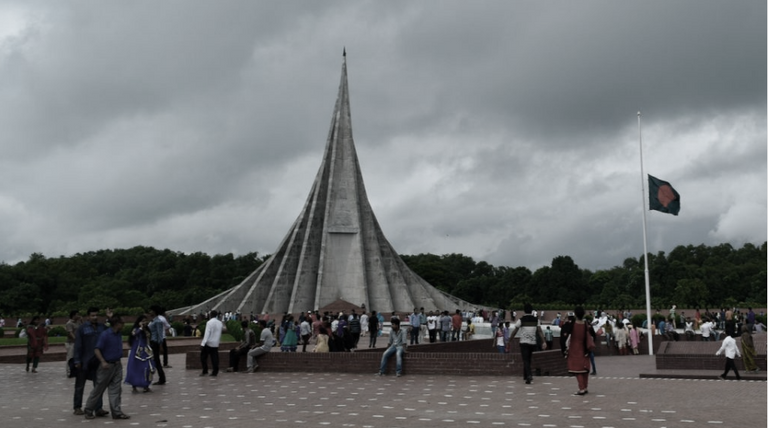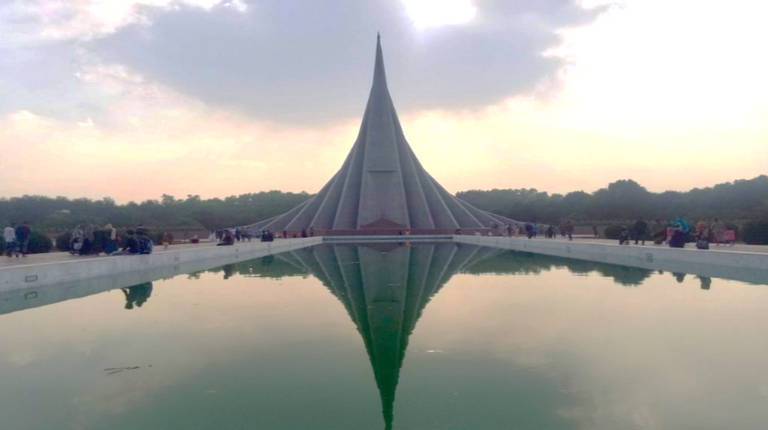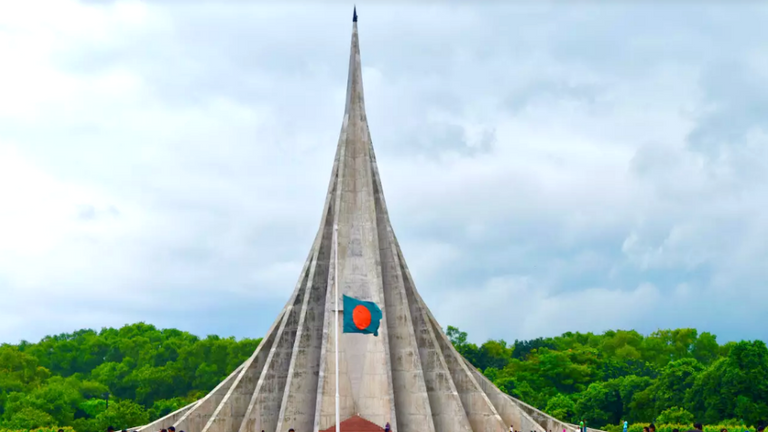জাতীয় শহীদ স্মৃতিসৌধ বাংলাদেশের জাতীয় স্মৃতিস্তম্ভ, যারা ১৯৭১ সালের বাংলাদেশের স্বাধীনতা যুদ্ধে নিহতদের স্মরণে স্থাপিত হয়েছিল, যা স্বাধীনতা এনেছিল এবং বাংলাদেশকে পাকিস্তান থেকে বিচ্ছিন্ন করেছিল। স্মৃতিস্তম্ভটি রাজধানী ঢাকা থেকে প্রায় ৩৫ কিলোমিটার উত্তর-পশ্চিমে সাভারে অবস্থিত। এটির ডিজাইন করেছেন সৈয়দ মইনুল হোসেন এবং নির্মাণ করেছেন কনকর্ড গ্রুপ।
1976 সালে স্মৃতিস্তম্ভের পরিকল্পনা শুরু করা হয়। স্থান নির্বাচন, রাস্তা ও ভূমি উন্নয়নের পর, 1978 সালের জুন মাসে একটি দেশব্যাপী নকশা প্রতিযোগিতা অনুষ্ঠিত হয়। 57টি দাখিলের মূল্যায়নের পর সৈয়দ মইনুল হোসেনের নকশা বেছে নেওয়া হয়। মূল কাঠামো এবং কৃত্রিম হ্রদ এবং অন্যান্য সুবিধা 1982 সালে সম্পন্ন হয়েছিল। এটি 16 ডিসেম্বর 1982-এ উদ্বোধন করা হয়েছিল।
স্থাপত্যটি সাত জোড়া ত্রিভুজাকার আকৃতির দেয়াল বা প্রিজমের সমন্বয়ে গঠিত; সবচেয়ে বাইরের জোড়াটি উচ্চতায় সবচেয়ে ছোট কিন্তু স্প্যানে সবচেয়ে প্রশস্ত, অভ্যন্তরীণ জোড়া ধীরে ধীরে তাদের আকৃতির অনুপাত পরিবর্তন করে এবং সবচেয়ে ভিতরের জোড়াটি এইভাবে স্থাপত্যের শিখর বিন্দু গঠন করে। এই সাত জোড়া দেয়ালের প্রতিটি বাংলাদেশের ইতিহাসে একটি উল্লেখযোগ্য অধ্যায়ের প্রতিনিধিত্ব করে, যথা 1952 সালে ভাষা আন্দোলন, 1954 সালে যুক্তফ্রন্টের প্রাদেশিক নির্বাচনে বিজয়, 1956 সালে সংবিধান আন্দোলন, 1962 সালে শিক্ষা কমিশনের বিরুদ্ধে আন্দোলন। , 1966 সালে ছয় দফা আন্দোলন, 1969 সালে গণঅভ্যুত্থান এবং অবশেষে 1971 সালে স্বাধীনতা যুদ্ধের ক্লাইম্যাক্টিক ঘটনা, যার মাধ্যমে বাংলাদেশ একটি পৃথক স্বাধীন সার্বভৌম রাষ্ট্রে পরিণত হয়।
বাংলাদেশে ডিসেম্বর মাসটি স্মরণ ও প্রতিফলনের সময়। ১৯৭১ সালের সেই মাসেই দেশটির স্বাধীনতা হয় মুক্তিযোদ্ধাদের বীরত্ব ও আত্মত্যাগকে স্মরণ করার জন্য। বাংলাদেশ স্বাধীন হওয়ার ১১ বছর পর ১৯৮২ সালের ১৬ ডিসেম্বর জাতীয় শহীদ স্মৃতিস্তম্ভ উদ্বোধন করা হয়। ঢাকার প্রায় 22 মাইল উত্তর-পশ্চিমে একটি শিল্প উপশহর সাভারে অবস্থিত, স্মৃতিস্তম্ভটি এখন একটি আইকনিক কাঠামো হিসাবে দাঁড়িয়ে আছে, যা বাঙালিদের স্ব-শাসনের অধিকারের জন্য তাদের জীবন উৎসর্গকারী পুরুষ এবং মহিলাদের প্রতি জাতির কৃতজ্ঞতাকে ধারণ করে। প্রতি বছর ডিসেম্বরে, এইভাবে, জাতীয় শহীদ স্মৃতিস্তম্ভটি জাতীয়তা উদযাপনে দেশের সম্মিলিত আচার-অনুষ্ঠানের কেন্দ্রবিন্দু হয়ে ওঠে।
স্মৃতিস্তম্ভটি একটি শ্যামল ভূমি থেকে উঠে এসেছে, যা বগুড়ার প্রাচীন শহর পুন্ড্রনগর মহাস্থানের ধ্বংসপ্রাপ্ত ঢিবির কিছুটা স্মরণ করিয়ে দেয়। প্রকল্পের প্রথম ধাপ 1972 সালে শুরু হয়েছিল, যখন সরকার প্রায় 110 একর জমি অধিগ্রহণ করেছিল। মূল কমপ্লেক্সের জন্য 84 একর জমির প্রয়োজন ছিল, বাকি জায়গাটি স্থল-জল গ্রিনবেল্টের জন্য বরাদ্দ করা হয়েছিল। প্রথম পর্যায়ে প্রবেশের রাস্তা তৈরি করা হয়। গণকবর, হেলিপ্যাড, পার্কিং স্পেস এবং ফুটপাথগুলি দ্বিতীয় পর্যায়ে 1974 এবং 1982 সালের মধ্যে নির্মিত হয়েছিল। মূল স্মৃতিস্তম্ভ, গ্রিনবেল্ট এবং ক্যাফেটেরিয়া নির্মাণের কাজ তৃতীয় পর্যায়ে, 1982 সালে হয়েছিল।
স্থপতি মুজহারুল ইসলাম সহ একজন হেভিওয়েট জুরির সাথে, 1978 সালে স্মৃতিস্তম্ভের জন্য একটি জাতীয় নকশা প্রতিযোগিতা অনুষ্ঠিত হয়। (আগের প্রচেষ্টার কোনো সন্তোষজনক ফলাফল আসেনি।) একজন 26 বছর বয়সী স্থপতি, সৈয়দ মাইনুল হোসেন (1952-2014) ), 57 জন অংশগ্রহণকারীর একটি পুল থেকে প্রতিযোগিতা জিতেছে। কিংবদন্তী হিসাবে, হোসেনের নকশা ছিল জুরিদের সর্বসম্মত পছন্দ: এটি অভিসারী প্লেনের একটি মৌলিক রচনার মাধ্যমে নতুন জাতির আকাঙ্ক্ষাকে সবচেয়ে মর্মস্পর্শীভাবে ক্যাপচার করেছিল, আরোহণের একটি মহৎ অঙ্গভঙ্গি অর্জন করেছিল।
যাইহোক, পিরামিডাল আইকনটিকে একটি একাকী ভাস্কর্য কাঠামো হিসাবে কল্পনা করা হয়নি। বরং, কমপ্লেক্সটি একটি সামগ্রিক ল্যান্ডস্কেপ হিসাবে ডিজাইন করা হয়েছিল, এক ধরণের জ্যামিতিক ট্যাপেস্ট্রি যা সবুজ এলাকা, জল, চলার পথ, ইট এবং কংক্রিটকে একত্রিত করে, সবই একটি উর্ধ্বমুখী স্মৃতিস্তম্ভে পরিণত হয়েছিল।
মূল উত্তরের প্রবেশদ্বার থেকে, দর্শনার্থীকে স্মৃতিস্তম্ভের সাথে একটি শক্তিশালী অক্ষীয় চাক্ষুষ সংযোগের সাথে উপস্থাপন করা হয়। তবুও, এটির দিকে যাত্রা ইচ্ছাকৃতভাবে জ্যাগড এবং অসম, উদাহরণস্বরূপ, তাজমহলের থেকে ভিন্ন, যেখানে অক্ষ বরাবর মুঘল মার্বেল সমাধির দিকে যাওয়া যায়। জাতীয় স্মৃতিসৌধের কঠিন পথটি স্ব-শাসনের জন্য জাতির কঠিন পথের পাশাপাশি সামনে থাকা চ্যালেঞ্জিং যাত্রার প্রতীক বলে মনে হয়।
এই ঘূর্ণায়মান উত্তরণটি দর্শককে একাধিক দৃষ্টিকোণ থেকে স্মৃতিস্তম্ভটি দেখার অনুমতি দেয়, দেখার অবস্থানের উপর নির্ভর করে এর নাটকীয়ভাবে ভিন্ন কনফিগারেশনের অভিজ্ঞতা লাভ করে। অনেকের কাছে, জাতীয় শহীদদের স্মৃতিস্তম্ভের চাক্ষুষ যাদুটি এর অপটিক্যাল বিভ্রমের মধ্যে নিহিত, সম্ভবত একটি পিকাসো-এসকু কিউবিস্ট টুইস্ট যা "জাতি" মানে।
এই বিভ্রমের অংশটি স্মৃতিস্তম্ভের পরিকল্পনা থেকেই উদ্ভূত হয়। সামনের দিকে দেখা গেলে, এটি একটি কাঠামো বলে মনে হয়, যদিও বাস্তবে তা নয়। স্মৃতিস্তম্ভের পরিকল্পনাটি সাতটি, স্বাধীন স্থায়ী কংক্রিটের প্লেটের একটি বিন্যাস। প্রতিটি একটি সমদ্বিবাহু ত্রিভুজ, কিন্তু উচ্চতা এবং ভিত্তি ভিন্ন মাত্রা সহ। প্লেটগুলি মাঝখানে 90-ডিগ্রী কোণে ভাঁজ করা হয়। সর্বোচ্চ প্লেটটির (150 ফুট) সবচেয়ে ছোট বেস (20 ফুট) এবং সবচেয়ে ছোট প্লেটের সবচেয়ে লম্বা বেস (130 ফুট) রয়েছে। ভাঁজ করা প্লেটগুলি 9 ফুট, 2 ইঞ্চি সমান্তরাল ব্যবধানে একের পর এক স্থাপন করা হয়। সর্বোচ্চ প্লেটটি সামনে, এবং সবচেয়ে ছোটটি পিছনে। এই কনফিগারেশনটি দুটি শক্তিশালী প্যারাবোলিক বক্ররেখা তৈরি করে যা সামনে থেকে দেখা গেলে মহিমান্বিতভাবে আকাশের দিকে উঠে। তবুও, একটি প্রদক্ষিণকারী দর্শকের কাছে, জাতীয় স্মৃতিসৌধটি একটি একক হিমায়িত স্থাপত্য অভিব্যক্তি উপস্থাপন করে। পাশ থেকে, প্যারাবোলিক ড্রামা সাতটি ক্রমবর্ধমান ত্রিভুজে রূপান্তরিত হয়। যা ধ্রুব থাকে তা হল আরোহনের অনুভূতি।
জাতীয় স্মৃতিসৌধের গঠনে সংখ্যাতত্ত্ব একটি গুরুত্বপূর্ণ ভূমিকা পালন করে, এথেনিয়ান পার্থেননের মতো প্রত্নতাত্ত্বিক কাঠামোর সংগঠিত নীতিগুলিকে স্মরণ করে, যেখানে সংখ্যাগুলি আদর্শ স্থাপত্য সৌন্দর্য এবং অনুপাতের দার্শনিক ভিত্তি হিসাবে দেখা হয়েছিল। জাতীয় স্মৃতিসৌধে জাদু সংখ্যা হল 7, যা বাংলাদেশের জাতীয়তাবাদী সংগ্রামের সময়কাল 1952 থেকে 1971 সালের মধ্যে যুগান্তকারী আন্দোলনের সংখ্যা। উদাহরণস্বরূপ, অন্যদের মধ্যে, 1952 সালের ভাষা আন্দোলনে 5+2=7 রয়েছে; 16 ডিসেম্বর, 1971 সালে স্বাধীনতা দিবস, 1+6=7; এবং 7 জন বীরশ্রেষ্ঠ (যুদ্ধ বীর) ছিলেন যারা মুক্তিযুদ্ধের জন্য তাদের জীবন উৎসর্গ করেছিলেন।
তা সত্ত্বেও, জাতীয় স্মৃতিসৌধের সংখ্যাগত রচনাটি এর মনোমুগ্ধকর এবং মায়াময় জ্যামিতির সামগ্রিক অভিজ্ঞতার চেয়ে কম গুরুত্বপূর্ণ বলে মনে হয়। এবং, শেষ পর্যন্ত, এমনকি এই জ্যামিতিটি ধ্যানমূলক স্মরণের উদ্দীপনার জন্য কম গুরুত্বপূর্ণ বলে মনে হয় যা এটি অনুপ্রাণিত করে।
1988 সালে, স্থপতি সৈয়দ মইনুল হোসেন জাতির চেতনাকে উন্নীত করে এমন একটি স্মৃতিস্তম্ভ তৈরি করার জন্য দেশের সর্বোচ্চ বেসামরিক সম্মাননা একুশে পদক লাভ করেন। তবুও, স্থপতির জীবন ছিল দুঃখজনক। তিনি তার জীবনের শেষ বছরগুলি সম্পূর্ণ স্ব-বিচ্ছিন্নতা এবং অজ্ঞাতসারে কাটিয়েছেন, কিছু ধরণের মানসিক অসুস্থতার কারণে, সম্ভবত প্যারানয়েড সিজোফ্রেনিয়া। স্থপতির ভুতুড়ে শেষ বছরগুলি আমাদের আর্নেস্ট হেমিংওয়ের উত্তেজক পরামর্শের কথা মনে করিয়ে দেয় যে প্রতিভা এবং মেল্যাঙ্কোলিয়ার মধ্যে একটি রহস্যময় সম্পর্ক রয়েছে।
এটি বাংলাদেশের স্বাধীনতার যাত্রার গল্প যেমন বলে, তেমনি জাতীয় শহীদ স্মৃতিস্তম্ভ একটি সুন্দর কোরিওগ্রাফি স্থাপত্যের গল্প বর্ণনা করে। এটি বিশ্বের সেরা স্মৃতিস্তম্ভগুলির মধ্যে স্থান হওয়া উচিত।
Translation:
The month of December in Bangladesh is a time of remembrance and reflection. The country's independence in that month in 1971 was followed by a yearning to memorialise the heroism and sacrifice of the freedom fighters. On December 16, 1982, 11 years after Bangladesh became an independent country, the National Martyrs' Monument was inaugurated. Located at Savar, an industrial suburb about 22 miles northwest of Dhaka, the monument now stands as an iconic structure, encapsulating the nation's gratitude toward the men and women who sacrificed their lives for the Bengalis' right to self-rule. In December every year, thus, the National Martyrs' Monument becomes the epicentre of the nation's collective rituals in celebrating nationhood.
The monument rises from a verdant land, somewhat reminiscent of the ruinous mound of the ancient city of Pundranagarain Mahasthan, Bogra. The first phase of the project was initiated in 1972, when the government acquired nearly 110 acres. The main complex required 84 acres of land, while the remaining area was allocated for a land-water greenbelt. Access roads were created during the first phase. Mass graves, helipads, parking spaces, and pavements were constructed during the second phase, between 1974 and 1982. Construction of the main monument, greenbelt, and cafeteria, occurred in the third phase, in 1982.
With a heavyweight jury, including architect Muzharul Islam, a national design competition for the monument took place in 1978. (The previous attempt didn't yield any satisfactory results.) A 26-year-old architect, Syed Mainul Hossain (1952-2014), won the competition from a pool of 57 participants. As legend has it, Hossain's design was the jury's unanimous choice: it captured most poignantly the new nation's aspiration through an elemental composition of converging planes, achieving a sublime gesture of ascension.
However, the pyramidal icon was not conceived as a stand-alone sculptural structure. Rather, the complex was designed as a holistic landscape, a sort of geometric tapestry weaving together green areas, water, walkways, bricks, and concrete, all culminating into a soaring monument.
From the main northern entrance, the visitor is presented with a strong axial visual connection to the monument. Yet, the journey toward it is deliberately jagged and uneven, unlike, for instance, that of the Taj Mahal, where the approach to the Mughal marble tomb continues along the axis. The tortuous path to the National Monument appears to symbolise the nation's difficult path to self-rule, as well as the challenging journey that lies ahead.
This winding passage also allows the visitor to see the monument from multiple perspectives, experiencing its dramatically differing configurations depending on the viewing location. To many, the visual magic of the National Martyrs' Monument lies in its optical illusion, perhaps a Picasso-esque cubist twist to what "nation" means.
Part of this illusion stems from the plan of the monument itself. Seen frontally, it appears to be one structure, while in reality, it is not. The plan of the monument is an arrangement of seven, independent standing concrete plates. Each is an isosceles triangle, but with different dimensions in height and base. The plates are folded in the middle at a 90-degree angle. The highest plate (150 feet) has the shortest base (20 feet), and the shortest plate has the longest base (130 feet). The folded plates are placed one after another at a parallel spacing of 9 feet, 2 inches. The highest plate is at the front, and the shortest is at the back. This configuration creates two powerful parabolic curves that majestically rise toward the sky, when seen from the front. Yet, to a circumnavigating spectator, the National Monument presents a singular frozen architectural expression. From the side, the parabolic drama morphs into seven progressively rising triangles. What remains constant is the feeling of ascension.
Numerology plays a crucial role in the composition of the National Monument, recalling the organising principles of such archetypal structures as the Athenian Parthenon, in which numbers were seen as the philosophical foundation of ideal architectural beauty and proportion. The magic number at the National Monument is 7, which is the number of landmark movements between 1952 and 1971, the period of Banglandesh's nationalist struggle. For instance, among others, the Language Movement in 1952 contains 5+2=7; December 16, the day of independence in 1971, has 1+6=7; and there were 7 birsreshto (war heroes) who sacrificed their lives for the cause of liberation.
Even so, the numerical composition of the National Monument seems less important than the overall experience of its captivating and illusive geometry. And, ultimately, even this geometry seems less important to the evocation of meditative remembrance that it inspires.
In 1988, architect Syed Mainul Hossain received the Ekushey Padak, one of the highest civilian honours of the country, for creating a monument that continues to uplift the spirit of the nation. Yet, the architect's life had been tragic. He spent the last years of his life in complete self-isolation and anonymity, due to some kind of mental illness, perhaps paranoid schizophrenia. The architect's haunting final years remind us of Ernest Hemingway's provocative suggestion that there is a mysterious correlation between genius and melancholia.
As much as it tells the story of Bangladesh's journey to independence, the National Martyrs' Monument narrates a beautifully choreographed architectural story. It should rank among the finest monuments in the world.
The writer is an architect, architectural historian, and urbanist, and teaches in Washington, DC, and is the author of Impossible Heights: Skyscrapers, Flight, and the Master Builder (2015) and Oculus: A Decade of Insights into Bangladeshi Affairs (2012).


